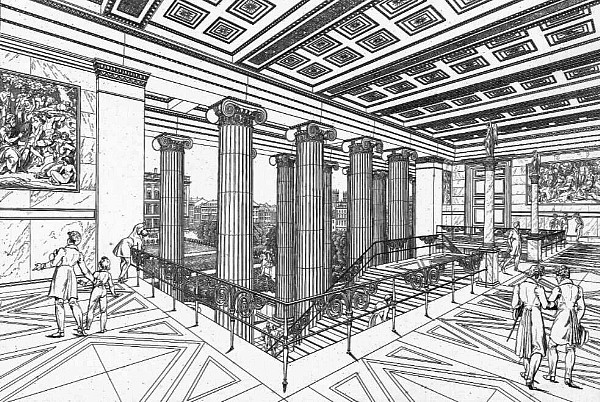1998.07.28
ideas
virtual Altes Museum: a new program for the Altes Museum, keeping the building as is, with only virtual additions. ...a redux of the murals within the porch and stair landing as hypersurfaces.
| |
1998.08.09
hypermural @ the Altes Museum
...first experiment regarding images of a hypermural at the Altes Museum.
| |
1998.08.27
new Quondam
...a museum to do with as I please. ...stream of consciousness and spontaneity... ...to use the museum to be hyper-creative with architecture.
| |
1998.11.13 15:11
Re: do tell
...hyper-surface architecture, which is perhaps so far the furthest development of architecture as show (and I use the word show here in its more broad sense, and I am not at all trying to be negative, although architecture as show probably contains both positive and negative attributes).
When I think of architecture and show, my mind makes all kinds of associations. First, I am hard pressed to think of an example of architecture that doesn't represent (show) something, and in that sense all architecture could be seen as some kind of show. Next, I think of how architecture is usually shown in photographs, that is, usually without people in the same picture. Could this be an indication of the autonomy that architects like to perceive in architecture? I'm reminded of a story an architect/friend's wife told about visiting Le Corbusier's Villa Savoye. There were a handful of other architects there, and not only was each of the architects taking virtually all the same pictures, but they were all making sure not to get each other in any of the pictures. I immediately thought the best pictures would have been of the architects doing this; at least that would have been a unique set of pictures. Could it be that the presence of people in architectural photographs takes away from architecture's (preferably?) perceived autonomy?
From here I think of Maya Lin's comments on the FLW/PBS show, where she says that Wright wanted far too much control of his designs (particularly in the cases where Wright designs all the interiors down to the smallest details and furthermore sets everything in a specific position). This is a great comment coming from the very artist whose Vietnam Memorial is exactly so great because of the people that visit and leave things there, and who, in there very own reflections in the wall of names, become a part of the monument itself. Finally, I think of K.F. Schinkel's perspective of the upper balcony of his Altes Museum where he shows visitors to the museum standing as if struck with awe of the architecture and its murals. Is it OK to have people within architectural images as long as they're showing high respect for the building?

|